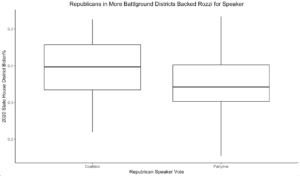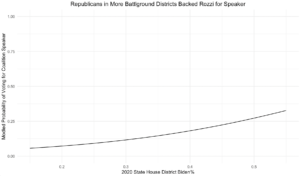Although Democrats won a slim 102-101 majority in the Pennsylvania State House during midterm elections last November, party operatives were unsure whether Democrats could convert this slim advantage into a true functioning majority in the chamber. Pennsylvania Democrats were forced to navigate a temporary 99-101 deficit in the State House while voting on a House Speaker, thanks to three temporary vacancies in safe blue seats. Mark Rozzi, a moderate Democrat from Berks County, brokered a deal to become Speaker of the Pennsylvania State House in a compromise with a handful of Pennsylvania Republicans. He was nominated by conservative Republican Jim Gregory, who he worked closely with to expand rights and legal actions for victims of childhood sexual abuse. Rozzi won the support of 15 other Republicans, including Republican floor leader Bryan Cutler, dominating the speaker vote by a 115-85 margin. As part of the agreement, Rozzi promised not to caucus with either party and serve as an independent speaker, presiding over a chamber that should eventually be deadlocked in a 101-101-1 partisan split after all vacancies are filled. Rozzi and other coalition supporters have not specified precisely how the chamber will function, but many conservative Republicans could be disappointed with the results. Pennsylvania Republicans hoped to advance amendments to the State Constitution that would have imposed more strict requirements to Voter ID law, which could have helped Republicans in the upcoming pivotal 2024 election. This sweeping conservative victory seems unlikely in such a closely fought chamber.
After hours of deadlock in the Pennsylvania State House on Tuesday, Gregory shockingly nominated Rozzi for the position. Democrats unanimously backed Rozzi’s speaker bid, but only 15 out of 101 Republicans in the chamber joined the majority coalition and voted for Rozzi. Representatives certainly weighed the political costs and benefits of backing Rozzi. While voting for Rozzi allowed each Republican to boost their moderate credentials and strength in general elections, voting against Rozzi would have allowed them to earn goodwill with the conservative base that dictates success in primary elections. For representatives strictly looking to maximize their chance of re-election, the partisanship of their district would play a large role in their eventual decision. Republicans representing battleground districts are more vulnerable in general elections, while Republicans in more red districts are likelier to be unseated in a primary election.
Republicans in battleground districts disproportionately helped Rozzi make his majority. While ~38% of “Coalition Republicans” represented a competitive district (where President Biden won >45% of the two-party vote in 2020), only ~14% of “Partyline Republicans” hailed from a competitive district.

Similarly, while ~33% of Republicans from a competitive district voted for Rozzi to be the Speaker of the Pennsylvania State House, only ~12% of Republicans from uncompetitive districts supported the coalition. As seen in the graphic below, the probability a single Republican backed the coalition increased exponentially as their district became more and more competitive, as predicted by logistic regression.
